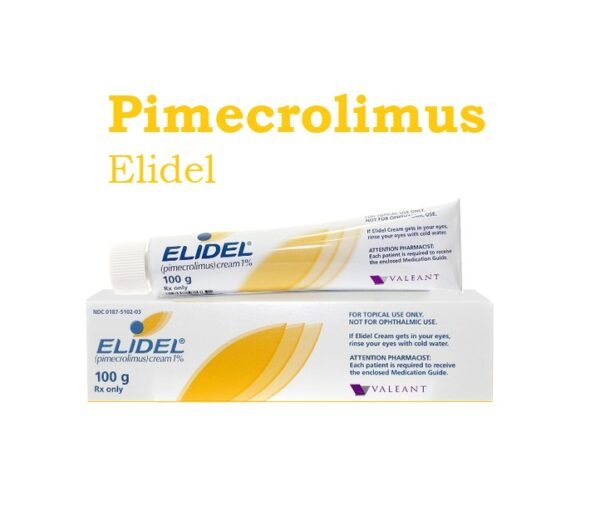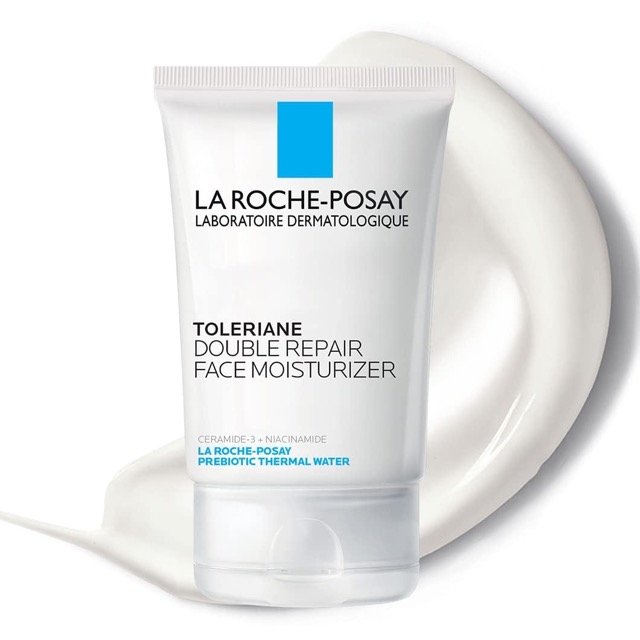Elidel (Pimecrolimus) is a calcineurin inhibitor for topical application. It inhibits the activation of T-cells in the epidermis of the skin when applied topically.
Elidel (Pimecrolimus) Uses:
- Atopic dermatitis:
- It is recommended as a second-line therapy for the short-term continuous treatment or long-term non-continuous treatment of mild to moderate atopic dermatitis in non-immuno-compromised patients older than 2 years of age who have not responded to other topical treatments or when other treatments are not possible.
- Use: Off-Label: Adult
- Oral lichen planus
- Vitiligo
- Intertriginous and facial psoriasis
Other calcineurin inhibitors include: Tacrolimus, sirolimus, temsirolimus, and everolimus.
Elidel (Pimecrolimus) Dose in Adults
Elidel (Pimecrolimus) Dose in the treatment of mild to moderate Atopic dermatitis:
- Apply a small coating twice a day to the afflicted region.
- Just apply the medication to the afflicted regions.
- As soon as the symptoms disappear, stop the medication.
- If no progress is shown after six weeks of therapy, reassess and reevaluate the patient.
Elidel (Pimecrolimus) Dose in the treatment of oral lichen planus (off-label):
- Apply over the affected area twice daily for one month.
Elidel (Pimecrolimus) Dose in the treatment of Psoriasis (off-label):
- Apply twice daily over the affected area.
Elidel (Pimecrolimus) Dose in the treatment of Vitiligo (off-label):
- Apply for six months, twice each day.
- Although a 12-month course of therapy could be beneficial, the drug's long-term safety has not been shown.
Elidel (Pimecrolimus) Dose in Childrens
Elidel (Pimecrolimus) Dose in the treatment of mild to moderate atopic dermatitis:
- Children over 2 years and Adolescents:
- Apply topically twice a day in a thin coating over the afflicted region.
- Ensure that you only apply to the impacted region.
- If after six weeks of therapy there is still no sign of change, re-evaluate and re-assess the patient.
- When the symptoms go away, stop.
Pregnancy Risk Factor C
- The topical application of topical creams did not cause adverse reactions in animal reproduction studies.
Pimecrolimus use during breastfeeding:
- It is unknown if the drug will be excreted into breastmilk.
- Manufacturers recommend that you stop breastfeeding, or that you use the drug. This is based on the risk and benefits of drug-exposure to your infant.
Elidel (Pimecrolimus) dose in kidney disease:
The manufacturer has not recommended any adjustments in the dose in patients with renal disease.
Elidel (Pimecrolimus) dose in liver impairment:
The manufacturer has not recommended any adjustments in the dose in patients with liver disease.
Common Side Effects of Elidel (Pimecrolimus):
- Central Nervous System:
- Headache
- Fever
- Infection:
- Influenza
- Local:
- Local Burning
- Application Site Reaction
- Respiratory:
- Nasopharyngitis
- Upper Respiratory Tract Infection
- Cough
- Bronchitis
Less Common Side Effects Of Elidel (Pimecrolimus):
- Dermatologic:
- Acne Vulgaris
- Herpes Simplex Dermatitis
- Folliculitis
- Skin Infection
- Impetigo
- Warts
- Molluscum Contagiosum
- Urticaria
- Gastrointestinal:
- Constipation
- Abdominal Pain
- Diarrhea
- Gastroenteritis
- Vomiting
- Toothache
- Nausea
- Infection:
- Staphylococcal Infection
- Varicella
- Viral Infection
- Herpes Simplex Infection
- Bacterial Infection
- Genitourinary:
- Dysmenorrhea
- Hypersensitivity:
- Hypersensitivity
- Local:
- Local Irritation
- Local Pruritus
- Localized Erythema
- Neuromuscular & Skeletal:
- Arthralgia
- Back Pain
- Otic:
- Otic Infection
- Otitis Media
- Ocular:
- Conjunctivitis
- Eye Infection
- Respiratory:
- Sore Throat
- Pharyngitis
- Tonsillitis
- Asthma
- Asthma Aggravated
- Streptococcal Pharyngitis
- Nasal Congestion
- Sinusitis
- Epistaxis
- Dyspnea
- Flu-Like Symptoms
- Pneumonia
- Rhinitis
- Rhinorrhea
- Viral Upper Respiratory Tract Infection
- Wheezing
- Miscellaneous:
- Laceration
Contraindications to Elidel (Pimecrolimus):
Allergy or sensitivity to pimecrolimus, any component of the formulation
Warnings and precautions
- Infection
- Patients with atopic dermatology are at greater risk for skin infections. Pimecrolimus, which can also be used to treat atopic dermatitis, may increase the likelihood of skin infections like varicella-zoster and eczema.
- Treat the local infection first before beginning medication.
- Do not apply the medication to locations where there are active viral and bacterial illnesses.
- Local symptoms
- In the first few days, local symptoms like burning, pruritus and stinging can be resolved by self-treatment. These symptoms may resolve as the lesions heal.
- Lymphadenopathy:
- It could be linked to lymphadenopathy. If lymphadenopathy is suspected, it is important to investigate infectious causes immediately.
- Patients with infectious mononucleosis and patients suffering from lymphadenopathy may have to stop receiving treatment.
- Malignancy: [US Boxed Warning]
- Patients with premalignant or malignant skin conditions, such as cutaneous T cell lymphoma, should not be given pimecrolimus or other calcineurin inhibitors.
- Rare cases of skin cancers and lymphomas have been linked to its use.
- Skin papilloma
- Pimecrolimus treatment may lead to the worsening or development of skin papilloma.
- If the condition is getting worse or the papillomas are not responding to standard treatment, discontinue the treatment.
- Atopic dermatitis:
- If clinical improvement does not occur within six weeks after treatment, discontinue the use of the product.
- Erythroderma
- Pimecrolimus safety has not been proven safe in patients with generalized acne. Avoid using it.
- Systemic absorption may be increased by skin diseases
- It should not be used by anyone who has Netherton's syndrome or any other skin problems.
Pimecrolimus: Drug Interaction
Risk Factor C (Monitor therapy) |
|
|
CYP3A4 Inhibitors (Moderate) |
Pimecrolimus's metabolism could be slowed down. Exceptions: Citrus Juice. Risk C: Follow-up treatment |
|
CYP3A4 Inhibitors (Strong) |
Pimecrolimus's metabolism could be slowed down. Risk C: Follow-up treatment |
Risk Factor X (Avoid combination) |
|
|
Immunosuppressants |
Immunosuppressants' harmful or hazardous effects may be increased by pimecrolimus. Cytarabine is an exception (Liposomal). |
Monitor:
- Monitor the response to therapy.
- Re-evaluate if no improvement is noted within six weeks of the treatment.
How to administer Elidel (Pimecrolimus)?
- Wash hands before and after applying for the medicine.
- A thin layer should be applied to the affected skin.
- Apply only to the area affected. Avoid applying occlusive dressings.
- Treatment with pimecrolimus may cause a burning sensation initially that improves when the condition starts to settle.
- If the symptoms persist beyond six weeks, re-evaluate the patient.
- Moisturizers may be applied over the area.
Oral lichen planus:
- To the oral mucosa that is impacted, use pimecrolimus.
- In order to prevent the medication from being diluted by saliva, cover it with a thin layer of gauze.
- After applying the medication, wait at least 30 minutes before eating, chewing, or drinking anything.
Mechanism of action of Elidel (Pimecrolimus):
- Pimecrolimus blocks the activation of T-cells in epidermis by inhibiting transcription of T-cell activating proinflammatory cytokine gene genes like IL-2, IL-4 and IL-10. It inhibits calcineurin binding to intracellular protein FKBP-12.
- This blocks the transcription of cytokines, and inhibits T cell activation.
- When stimulated with antigens/ IgE, it also stops the release of inflammatory mediators from mast cells.
The beginning of action:
- For significant improvements to be seen, it takes around eight days.
Absorption:
- It is very absorbent when applied topically.
- The drug was administered to treat atopic dermatitis and the blood concentration was not more than 2 ng/ml, despite the fact that the drug had a body surface area of 13-62 percent.
- Because of the large body surface area and high body mass, blood concentrations can be higher in pediatric patients.
Protein binding:
- The majority of the drug's 99.5% protein binding is to lipoproteins.
Metabolism:
- It is metabolized by the liver via cytochrome (CYP) P450 3A4
Excretion:
- Feces (78.4% as metabolites; <1% as unchanged drug)
Half-life elimination:
- Terminal half-life after oral administration is about 30 to 40 hours.
Time to peak serum concentration when applied topically:
- two to six hours
International Brands of Pimecrolimus:
- Elidel
- Pimecroderm
- Pimoroyal
Pimecrolimus Brand Names in Pakistan:
No Brands Available in Pakistan.







